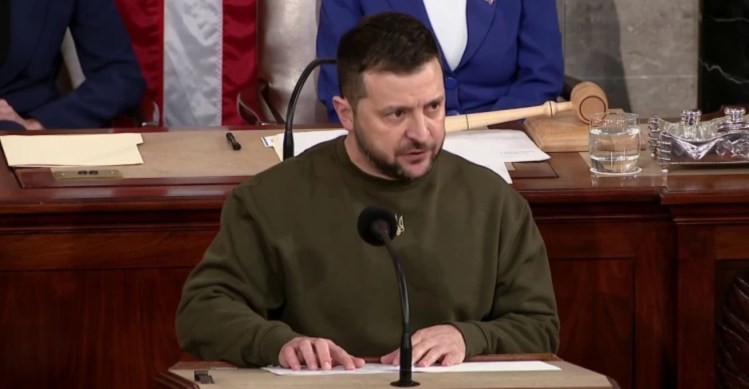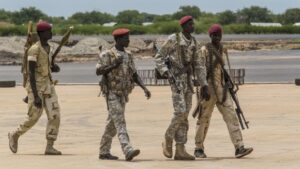The Changing Nature of Warfare for Ukraine
It is an interesting political and moral conundrum when Ukrainian President Zelenskyy is compelled to explain his government’s actions via an almost tacit apology for defending their nation, their people, and their way of life. This month has seen the Ukrainian military execute offensive operations once believed impossible – counterattacks on both militarily significant targets and symbolic targets in the Kursk region of Russia. This represents a change in the character of war for the Ukrainians. With the size and scope of Russian losses impacting all facets of Russian society, these Ukrainian counterpunches have hit the psyche of Russian commanders and the Russian people while also hitting the ego of Russian President Vladimir Putin. The war to conquer Ukraine is lost, and it is now up to Russia to remind Putin that his legacy will be another needless sacrifice of a generation – another failed Stalinist approach to foreign policy.
The average reign of a military dictatorship is about five years. Vladimir Putin has extended his personalist dictatorship to twenty years. Still, we can expect him to cling to power until at least 2036 through multiple manipulations of the Constitution of the Russian Federation. It is a constitution in name alone, with Putin pulling all diplomatic, economic, military, and juridical levers from his bunker in the Kremlin. Even with a complete consolidation of power, Putin’s unconstrained use of force in Ukraine will be his demise. He continues to strike at known civilian targets and recently targeted the home of Ukrainian President Zelenskyy.
Office of the United Nations High Commissioner for Human Rights (OHCHR) verified a total of 35,160 civilian casualties during Russia’s invasion of Ukraine – July 31, 2024
The ever-poker-faced Putin, with hubris long morphing to arrogance, continues to ignore the realities that anyone with an iPhone and an internet connection can see – a failed military campaign, open charges of war crimes from the International Criminal Court, a crumbling Russian economy, and a tightening NATO noose around a faltering and desperate Russian Federation. The loss of more than six hundred thousand Russian troops, eight thousand tanks, sixteen thousand armored vehicles, twenty-five ships, and a staggering seven hundred airplanes and helicopters far exceeds the losses of the Soviet Union’s ten-year war in Afghanistan.
A Ukrainian soldier looks over the remains of a destroyed Russian tank in Lukyanivka, Ukraine.
The sustained loss of equipment and personnel has been mirrored by a growing political and economic isolation from the West and Russia’s more traditional trading partners. Economic sanctions have ranged from the seizure of oligarch super yachts to the freezing of assets held in international financial institutions. Those financial losses, estimated at seventy billion dollars, only compound the economic issues in Russia – Russians are being transported fifty years into the economic past.
Economic and Social Impact on Russia
The fall of the Berlin Wall and the advent of “Perestroika,” or economic restructuring, in 1989, Russia paved the way for the economic boom that would follow. By the early 2000s, Russia had major foreign investment. This included Boeing factories, eight hundred and fifty McDonald’s restaurants, the largest PepsiCo factory in the world, eight billion in Citigroup investments, thirteen hundred Phillip Morris employees, and the list goes on. United States and European companies believed investing in both the Russian economy and the Russian people was a balanced approach and worth the risks.
That all changed in February of 2022 after Vladimir Putin’s “special military operations“ in Ukraine began. Since then, one thousand foreign companies have left Russia with no plans to return. The same people who clamored for Levi jeans during the Cold War are left with hyperinflation, unemployment, and an economy that shows all the signs of a meltdown. Any real growth reported in the Russian economy is artificially inflated by gas & oil sales along with required military spending to support the war in Ukraine.
Outside the financial costs, the cost to the Russian psyche cannot be underestimated. This war has stripped from them any sense of modernity. Russian citizens have no real vote, no voice – just another “election“ victory by Putin earlier this year to show them how unimportant they are. Russians have lost more than buying power. Since 1989, the last two generations of Russians have enjoyed the advantages of a free market, but that has been replaced with price controls, supply shortages, and conscription. The lingering ideologies and values of Trotsky, Lenin, and Stalin continue to crush the dreams of generations.
The Changing Nature of Warfare for Ukraine
It is an interesting political and moral conundrum when Ukrainian President Zelenskyy is compelled to explain his government’s actions via an almost tacit apology for defending their nation, their people, and their way of life. This month has seen the Ukrainian military execute offensive operations once believed impossible – counterattacks on both militarily significant targets and symbolic targets in the Kursk region of Russia. This represents a change in the character of war for the Ukrainians. With the size and scope of Russian losses impacting all facets of Russian society, these Ukrainian counterpunches have hit the psyche of Russian commanders and the Russian people while also hitting the ego of Russian President Vladimir Putin. The war to conquer Ukraine is lost, and it is now up to Russia to remind Putin that his legacy will be another needless sacrifice of a generation – another failed Stalinist approach to foreign policy.
The average reign of a military dictatorship is about five years. Vladimir Putin has extended his personalist dictatorship to twenty years. Still, we can expect him to cling to power until at least 2036 through multiple manipulations of the Constitution of the Russian Federation. It is a constitution in name alone, with Putin pulling all diplomatic, economic, military, and juridical levers from his bunker in the Kremlin. Even with a complete consolidation of power, Putin’s unconstrained use of force in Ukraine will be his demise. He continues to strike at known civilian targets and recently targeted the home of Ukrainian President Zelenskyy.
Office of the United Nations High Commissioner for Human Rights (OHCHR) verified a total of 35,160 civilian casualties during Russia’s invasion of Ukraine – July 31, 2024
The ever-poker-faced Putin, with hubris long morphing to arrogance, continues to ignore the realities that anyone with an iPhone and an internet connection can see – a failed military campaign, open charges of war crimes from the International Criminal Court, a crumbling Russian economy, and a tightening NATO noose around a faltering and desperate Russian Federation. The loss of more than six hundred thousand Russian troops, eight thousand tanks, sixteen thousand armored vehicles, twenty-five ships, and a staggering seven hundred airplanes and helicopters far exceeds the losses of the Soviet Union’s ten-year war in Afghanistan.
A Ukrainian soldier looks over the remains of a destroyed Russian tank in Lukyanivka, Ukraine.
The sustained loss of equipment and personnel has been mirrored by a growing political and economic isolation from the West and Russia’s more traditional trading partners. Economic sanctions have ranged from the seizure of oligarch super yachts to the freezing of assets held in international financial institutions. Those financial losses, estimated at seventy billion dollars, only compound the economic issues in Russia – Russians are being transported fifty years into the economic past.
Economic and Social Impact on Russia
The fall of the Berlin Wall and the advent of “Perestroika,” or economic restructuring, in 1989, Russia paved the way for the economic boom that would follow. By the early 2000s, Russia had major foreign investment. This included Boeing factories, eight hundred and fifty McDonald’s restaurants, the largest PepsiCo factory in the world, eight billion in Citigroup investments, thirteen hundred Phillip Morris employees, and the list goes on. United States and European companies believed investing in both the Russian economy and the Russian people was a balanced approach and worth the risks.
That all changed in February of 2022 after Vladimir Putin’s “special military operations“ in Ukraine began. Since then, one thousand foreign companies have left Russia with no plans to return. The same people who clamored for Levi jeans during the Cold War are left with hyperinflation, unemployment, and an economy that shows all the signs of a meltdown. Any real growth reported in the Russian economy is artificially inflated by gas & oil sales along with required military spending to support the war in Ukraine.
Outside the financial costs, the cost to the Russian psyche cannot be underestimated. This war has stripped from them any sense of modernity. Russian citizens have no real vote, no voice – just another “election“ victory by Putin earlier this year to show them how unimportant they are. Russians have lost more than buying power. Since 1989, the last two generations of Russians have enjoyed the advantages of a free market, but that has been replaced with price controls, supply shortages, and conscription. The lingering ideologies and values of Trotsky, Lenin, and Stalin continue to crush the dreams of generations.
When communism failed, it wasn’t a good idea that had gone wrong; it was a bad idea that had been sustained with incredible determination in the face of all the commonsense arguments, and at the cost of 20 million lives, at least, in Russia, to build the socialist Utopia. – Sir Martin Louis Amis: English Novelist
NATO’s Role and Ukraine’s Resilience
Even with the failing economy, the Kremlin believes there is a way to manipulate and intimidate NATO to abandon their military and financial support to Ukraine – another delusion. The billions lost by the Kremlin have been compounded by hundreds of billions of military aid being delivered by NATO to Ukraine – this includes military training, intelligence, and logistic support. Inside the military support is modern military equipment such as main battle tanks, armored fighting vehicles, HIMARS rocket systems, and aircraft. Most notably, F-16 strike fighter aircraft has become operational from Ukrainian air bases.
Though the arrival of F-16s has been purposefully secretive, the F-16 has been a symbolic victory for Ukraine and for NATO – an overt call of Vladmir Putin’s bluff that providing F-16’s would cross an undefined “line in the sand“. The Kursk offensive shows there is no respect or fear of Russian reprisals. The offensive is designed to provide a buffer zone for Ukrainians who live in the border region while sending an even stronger message. The advance has been an effective boost of Ukrainian morale and solidarity while giving the proverbial “bird“ to the Kremlin; six hundred square miles of Russian territory captured by Ukrainian forces is no small feat.
“We have tasted freedom, and we will not give it up.“ — Volodymyr Zelensky.
The Kursk operation is a qualitative and quantitative affirmation of how combining NATO commitments with Western ideals can be effective. The importance of the NATO alliance cannot be overstated, and the Ukrainian’s offensive is symbolic of a retooled, retrained, and reinvigorated Ukrainian military. They have the capability to employ military forces at the time and place of their choosing. Their deployment in the Kursk region is not just a demonstration of their upgraded capabilities; it is a bold statement of resolve and solidarity – something the Kremlin could not have ever imagined.
NATO and those who support a free Ukraine must put aside any cries from the far right or the far left, and certainly from pro-Russian media, that Ukraine is somehow responsible for expanding the war. The people of Ukraine were mercilessly attacked, subjected to war crimes, and tormented by a dictator bent on showing the world his power. The army Putin expected the Ukrainians to roll over and bend at the knee. He grossly underestimated his enemies and overestimated the capability of his conscripted army.
Since the invasion of Ukraine more than two and a half years ago, it has been a living nightmare for Russians and Ukrainians alike. Vladimir Putin has unsuccessfully gambled the future of the Russian people on his war. As Russian forces are defeated in the Kursk region – they continue to withdraw forces from inside Ukraine to defend the homeland – even Russia’s fiercest propagandists must be concerned. The Ukrainians, with the support of NATO allies, have pierced Russia’s veil of military invincibility and exposed a despot willing to risk their collective futures. Now is the time for every Russian to demand peace and for them to hold their president accountable.
—
Disclaimer: SOFREP utilizes AI for image generation and article research. Occasionally, it’s like handing a chimpanzee the keys to your liquor cabinet. It’s not always perfect and if a mistake is made, we own up to it full stop. In a world where information comes at us in tidal waves, it is an important tool that helps us sift through the brass for live rounds.



